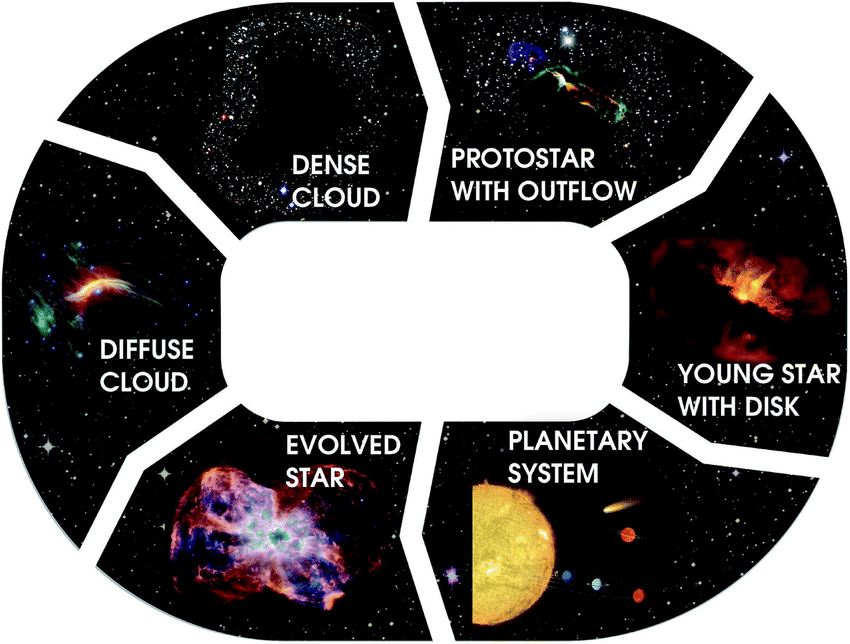Overview#
Copied from Chapter 1#
Warning
need to better understand ice structure and dynamics (in all the ice related fields).
1.1 The Dust cycle in the Galaxy#
Note
Set up the scene
Different environment of the ISM
Dust in ISM + gas H2 formation
Coms
The human eye is sensible to the visible part of the electromagnetic spectrum (400-800nm) allowing for observation of Stars in our galaxy and beyond, but the Inter-Stellar Medium (ISM) although invisible to the naked eye, is made of a rich variaty in environments all made of two key ingredients, Gas and Dust.
Both are probed and investigated using telescopes, operating at different wavelength.
ALMA (radio) - rotational energy
Spitzer / JWST (IR) - vibration

Fig. 1 Dust and Ice cycle in the galaxy. Figure adapted from [Yamamoto et al., 1995]#
Article complete freezout in prestellar core [Caselli et al., 2022]
Update diagram with prestelar core section.
Also add Earth upper atmosphere section - Ice present in upper atmosphere {cite:p}
Dust form in the outer shells of stars and supernovae and are dispersed into the diffuse ISM. ISM various environment Molecular clouds where grains are shielded from radiation, form seeds for ice to form Ice formation processes, atomic deposition and water formation, desorption and readsorption (during early stage of stage formation) . Complex Organic Molecules (COMs) in Molecular clouds (link with molecular diversity in planetary systems, comets - asteroids) Chemistry within the ice Different chemical processes (Rachel diagram) Lab astronomy to mimic those processes Amorphous Solid Water review Challenges with ASW Porosity, gas adsorption versus small angle neutron scattering Ice is very important but complex and still poorly understood
1.2 Synergy Between Experiments, Modelling and Observation in Astronomy through the Prism of Ice#
Note
Background of the story, where do I fit
Ice coverage of interstellar dust grain in cold environment [Potapov et al., 2020] –> thiner than expected
1.3 Water Ices#
Water phase Diagram#
What makes our planet so special is its ability to sustain water in all it’s physical states, liquid, solid and gas. Dependant on Pressure and Temperature condition.
Water phase diagram is complex
Ice nucleation and growth#
Ice crystal fromation and growth is of relevance for many scientific fields:
Biology, cryopreservation
Physics, Cloud formation
Engeneering, aircraft wings
…
Crystaline Ice#
18 (more!) crystaline forms. The more common is hexagonal ice. Water molecule within the hexagonal crystal is anisotropic (double check). Cubic ice is isotropic (?) On Eart stable form is hexagonal ice (Ih)
Crystaline structure of Hexagonal (Cubic Ice) ?#
Ice rules.
Check isotropy for bond length in ice crystal.
Crystal space group (P63/mmc - ref ) https://en.wikipedia.org/wiki/Space_group
Symmetry (D6H) to confirm https://water.lsbu.ac.uk/water/hexagonal_ice.html
a,b,c spacing (primitive cell dimention)
Amorphous Solid Water has been an intense subject of study since it’s discovery in 1935 [BURTON and OLIVER, 1935] due to :
It’s similarity to supercoooled water
It’s potential catalytic role in the formation of complex organic molecules (COMs) in interstellar space […], and even in Earth upper atmosphere. - ie similar to a solvent
[…] keep implementing
1.4 Amorphous Ices in the Laboratory#
Note
Introducing the main character
Method of production#
Different production routes will lead to different amorphous ices, hence water is said to be polyamorphique. Various classifications have been employed … (cf Jenniskens …).
Best qualification achieved by Loerting et al [Loerting et al., 2011]
Low density vs High density#
HDA / vHDA - relevance to Icy satellites …
We are more interested in low density Amorphous ice as it is assumed to be the material covering interstellar dust grain.
ASW/HGW LDA I / LDA II [Winkel et al., 2009]
How similar are they ? Scattering O-O pair distribution function.
Vapor deposited or liquid phase#
1.4 Ice Processing in the Context of Planet Formation#
Note
Thread of adventures experienced by the hero
1.5 Thesis Motivation and Aim#
Note
Thread of adventures experienced by the hero
The aim of this thesis is to better characterise the processes at play during crystalisation of water ice. Two approach:
Bottom-up going from amorphous solid water vapor deposited to hexagonal ice
Top to bottom going from liquid water to Hyperquenched Glassy Water (HGW)
1.6 Thesis Outline#
Note
How they will be adressed
Where in space are we#
Note
Insert red box with we are here arrow to show at what location we are

Fig. 2 The lifecycle of gas, dust and ice in interstellar and circumstellar clouds. Credit: M. Persson, NASA/ESA/ESO/ALMA#
I guess the best place to start is by looking at ice ❄ ,
Amorphous Solid Water Ice (ASW)
shema dust grain

Fig. 3 Interstellar Dust Grain (include ref Burk 2010)#
Link to teaching:
Dust
Amorphous ice
The launch of JWST will open a new era for Astrochemistry.
Need some experimental lab spectra to fit observations.
Ice age program - link to JWST course upstream
Example#
Use alexi code with Spitzer Data
Aim#
Systematic study of Amorphous Solid Water
Ice Databases
margin
Only 2 water Spectra